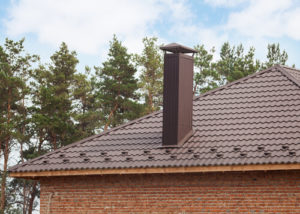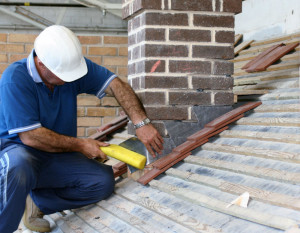While all parts of the chimney serve a specific purpose, few are as important as the chimney cap. A quality chimney cap can protect your entire fireplace system and keep it in good condition for years to come.
What is a chimney cap?
A chimney cap is a fitted metal hood that sits on top of the chimney structure and protects the top of the flue. Chimney caps have a solid top and mesh or wire sides. The solid top protects the chimney from moisture, animals, and debris while the open sides allow smoke and gas to safely vent.
Three ways a chimney cap protects your home
The following are three of the ways installing a chimney cap can protect your fireplace system.
1. Keep animals out
Raccoons, squirrels, birds, and other animals view chimneys as a safe, dark, enclosed and protected place to hide from predators and build nests. Unfortunately, animal entry can cause serious damage to your fireplace and chimney.
Animals damage the chimney and fireplace in a number of ways. First, they can scratch interior fireplace components such as the chimney liner. If your chimney has a clay tile liner, it may be necessary to reline the entire flue. Animal entry also increases the risk of chimney fire; nesting materials, food, and droppings can become dry in the flue and accidentally ignite from a stray spark or ember. The presence of animals in the chimney can also expose your family to diseases and pests such as lice or maggots – as well as the smells associated with a trapped animal.
2. Reduce risk of accidental fire
While fireplace safety and chimney maintenance significantly reduces the risk of chimney fire, chimney caps are an additional level of protection against accidental fires. First, the solid metal top and mesh sides act as spark catchers; it prevents embers, sparks, and hot coals from landing on the roof. Chimney caps also reduce the risk of fire by keeping debris out of the chimney. This keeps them from accumulating in the flue and drying out or catching fire.
Water from rain, sleet, snow, ice, and even sprinklers and hoses can be extremely damaging to your chimney. While fireplace and chimney components are designed to withstand extreme heat, even small amounts of moisture can cause significant damage.
Whether it is from a few droplets of a serious leak, water wreaks havoc throughout the chimney. Moisture can cause cracks in clay tile chimney liners, rust dampers, and even damage surrounding insulation, ceilings, and building materials. The combination of water along with the dark, moist chimney can also lead to mold and mildew growth.
Have your chimney cap inspected today!
A quality, well fitting chimney cap is an important part of protecting your entire chimney system. Contact the experts at Jack Pixley Sweeps to schedule your next chimney cap inspection. Our expert staff of CSIA certified chimney sweeps can ensure your chimney cap is in good condition, recommend necessary repairs, or even help you find a new chimney cap for your fireplace system.
A chimney is not simply one solid piece of masonry. Instead, it is a complex structure with a number of important components that work together to help the fireplace burn safely and efficiently.
What is a chimney crown?
The chimney crown is a slab of stone or masonry that sits on the top of the chimney, covering the top of the chimney and sealing the space around the flue. This helps protect against water entry while also protecting the masonry of the chimney structure.
Chimney crowns often suffer the worst exposure to the elements out of any chimney component. Because of this, it is important that the crown is built using quality materials and good building practices. Doing this will help extend the life of the chimney crown and protect the fireplace system.
While they may look flat from the street, chimney crowns are actually built with a slight slope. This prevents water from pooling on top of the chimney crown and encourages correct drainage. Likewise, chimney crowns also have an overhang known as a kerf. Extending several inches over the edge of the chimney, the kerf directs water onto the roof instead of directly onto the masonry of the chimney.
Chimney crown damage and repair.
Damage to the chimney crown can be difficult to immediately recognize, especially if you do not regularly climb onto the roof. Because of this, chimney crown damage is typically discovered during chimney sweepings or inspections rather than because of performance problems.
Chimney crown damage typically occurs due to a combination of overexposure to the elements and poor construction. Their location and purpose mean the chimney crown is exposed to more water than most other chimney elements; this makes it more prone to leaks and cracking. Likewise, poor construction or using improper building materials can also cause the chimney crown to prematurely deteriorate.
If damage to the chimney crown is discovered, it is important to have it repaired as soon as possible. The type of repairs needed while depend on the cause and severity of the damage; small, hairline cracks may be simple masonry repairs, whereas extensive damage could require a full chimney crown rebuild.
In addition to chimney crown repairs, a waterproof sealant may be recommended. Applying CrownCoat, flexible waterproof sealant, can protect your chimney crown against further water entry or water damage.
The chimney crown plays an important role in protecting your chimney system. Because of this, it is important to have it inspected regularly for signs of damage or deterioration. To schedule your next chimney inspection or for more information about protecting your chimney crown with CrownCoat, contact Jack Pixley Sweeps today!
While a little water in your fireplace might seem like only a minor inconvenience, it can spell major trouble for your chimney system. Whether it’s a few droplets, a large puddle, or even a musty smell, the presence of water in your fireplace and chimney can cause damage to many different chimney components.
Causes of leaky chimneys
Because chimneys are complex structures with a number of different components, there is no one guaranteed cause of a leaky chimney. However, there are several common ways that water can get in; below are four of the most common causes of chimney leaks.
- Chimney cap: Chimney caps are metal covers that protect the top of the flue and keep animals, debris, and moisture out of the chimney. If a chimney cap is installed incorrectly, does not fit properly, or is damaged, water can easily enter the flue and chimney.
- Chimney crown: The chimney crown is the mortar slab that covers and seals the top of the chimney. Well-built chimney crowns are typically made of concrete or other stone to prevent the chips and cracks associated with long term exposure to the elements. Likewise, a good chimney crown should have overhangs and be slightly sloped in order to prevent water from pooling or draining directly onto the masonry of the chimney.
- Damaged masonry: Damage caused by water can cause bricks to crack and spall; not only does this let additional water into the fireplace system, but it can also affect the structural stability of the chimney structure.

- Flashing: Chimney flashing are the layered metal strips that seal the joint between the roof and the chimney structure. Flashing can lose its watertight seal due to exposure to the elements, incorrect installation, damage from storms, or if changes to the roof line are made.
Repairing a leaky chimney
The first step to fixing a leaky chimney is to identify and repair the underlying cause of the leak. A chimney inspection done by a certified chimney sweep is often the best way to uncover where water is getting into the chimney system; by fixing how the water is getting in first, you can avoid needing the same chimney repairs because of water damage again and again.
In addition to repairing your leaky chimney, preventative maintenance can be done to protect your chimney against water damage. Waterproofing is one of the best ways to protect your masonry against water entry. Our professional-grade SaverSystems sealants are specially designed to work on masonry; these sealants allow the masonry to retain its semi-porous nature, allowing gasses to pass through but preventing moisture from getting in. Water repellent sealants can even be used if your masonry already has areas of water damage!
If you have a leaky chimney, it is important to have it repaired as soon as possible. Contact the experts at Jack Pixley Sweeps today for more information on how we can fix your leaky chimney!

Not sure what a chimney crown is or why it’s important? Learn why below!
In the past, we have had customers come to us to fix what other companies have previously repaired. Not only does this cost them far more money in the long run, but it also typically means their chimney has been further damaged. When it comes to chimney repairs, the lowest bid does not always equal the best service.
What are chimney crowns?
A chimney crown, sometimes known as a chimney wash, is the slab that covers the top of the chimney structure. Chimney crowns are important because they protect both the interior and exterior chimney structure from the elements. An improperly installed or damaged chimney crown can expose the interior of the chimney and fireplace to rain, snow, and other moisture while simultaneously exposing the brick and mortar of the chimney itself.
What to look for in a chimney crown
Although they can be difficult to inspect from the ground, there are several hallmarks of good chimney crowns that homeowners should be aware of. The first is the overhang, or drip ledge. To prevent water from flowing directly onto the masonry of the chimney structure, chimney crowns should have a drip ledge of at least 2 to 2.5 inches on all sides. These overhangs serve as miniature gutters, protecting the brickwork and mortar from direct exposure to rain and snow.
Another detail to look for is the material the chimney crown is made of. While regular masons may be qualified to lay bricks and mortar for a chimney, the same materials should never be used for the chimney crown itself. Because brickwork and mortar are porous materials, they should never be used to construct a chimney crown. If your chimney crown is made of mortar, it will quickly crack and deteriorate due to exposure to the elements. Instead, crowns should always be constructed from solid metal, stone, or concrete slabs.
Chimney crown supporting structures
While not technically part of a chimney crown, chimney flashing is an important structural element that also helps prevent moisture from entering a chimney structure. Even with a properly sized overhang, flashing is an additional layer of protection against the elements. Often made of metals such as aluminum, galvanized steel, or copper, flashing is designed to create a waterproof seal between the chimney and the roof itself.
However, flashing is often improperly installed which may cause the waterproof seal to be broken. Roofers often use too many nail holes, creating tiny crevices from rain and snow to gain access to the brick and mortar underneath. Likewise, over time the flashing may become loose or damaged, especially in areas prone to severe weather.
At Jack Pixley Sweeps, we can do more than just clean and inspect your fireplace. Our masons are specially trained to craft chimney crowns that are constructed with extreme attention to detail. While our services may not always be the least expensive, our chimney crowns are guaranteed to protect your chimney and last for years to come.
Types of Masonry Restoration
Masonry materials are remarkably durable — it’s why we can go to Europe and see masonry structures that are still standing (sometimes standing strong) after hundreds and hundreds, sometimes thousands of years. It’s also why chimney professionals like Jack Pixley Sweeps have been using bricks, mortar and other masonry materials to build chimneys for hundreds of years too.
The truth is, though, masonry will degrade and sustain damage at some point. That damage can come from many directions, whether it’s a fire or seismic event or the simple but damaging wear-and-tear of rain, snow and other forms of moisture (including the freeze/thaw process, during which moisture makes its way into small imperfections, then expands with freezing temperatures and busts open the masonry from the inside out).
Still, in a lot of cases, masonry can be repaired or restored. And at Jack Pixley Sweeps and Masonry, we’ve been bringing minimally and majorly damaged masonry chimneys back to beauty and function since 1977. If your masonry needs expert attention, we can help.
Some Of The Masonry Restoration Work We Can Do For You
Whether you have a historic home with a historic chimney to match it or a nearly new chimney, Jack Pixley Sweeps and Masonry technicians can take care of the work you need — we blend modern tools, technology and processes with techniques that have carried through from the early days of our trade. Some of what we can do:
Repairing And Restoring Damaged Chimney Crowns
Your masonry chimney crown’s placement — horizontally, at the very top of the chimney, directly open to baking sun and pounding rain and collecting snow — means it has a key job, but takes a beating. Its role of diverting moisture away from your flue can’t be accomplished well when sun and rain make cracks or spalling masonry develop. We can bring your crown back to proper function, whether we’re dealing with small cracks or a major breakdown.
Refacing A Lackluster Or Damaged Fireplace

Over the years, your chimney needs repair and replacement just like other appliances. Here is some more information.
If your fireplace is showing its age — with stains or damage — or if you just feel its look isn’t working in your home, we can help. We specialize in fireplace front redos that can bring a freshened look or a totally different aesthetic to your fireplace, while ensuring that it functions as effectively and safely as it should. Talk to us about what you think your fireplace needs!
Rebuilding A Failing Firebox
Since it holds the fire itself, your firebox has to stand up to some serious heat, time and again. And if the masonry begins to weaken — crumbling bricks, cracked masonry — it’s not just an eyesore, but a danger.
If your firebox needs an overhaul, we can remove the damaged brick and replace it with strong, new firebricks and refractory mortar. When we’re finished, you’ll have a beautiful firebox that’s built with care, experience and attention to detail, so you can enjoy your fires with the peace of mind that comes with knowing you brought in experts to handle its rebuild.
Rebuilding Chimneys From The Ground Up
When chimney damage is too extensive to make repairs a safe bet, a teardown and rebuild is necessary. It’s an extensive process, but here’s the particularly good news that comes with hiring Jack Pixley Sweeps and Masonry technicians to handle the job: We use time-tested methods to construct our chimneys in a way that provides a beautiful look and vastly extends their service life. We’ll be glad to tell you more about the way we work and how it’s different — just tell us about your project, and we’ll tell you what we can do for you!
If you need masonry restoration work done, or just have any chimney care questions you’d like help with, give Jack Pixley Sweeps and Masonry a call. We’re always here for our valued clients!




